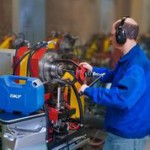
Correct dismounting adds to machine performance
Published: 25 July, 2019
Proper dismounting of damaged bearings – using one of four proven techniques, and the correct tooling – is as important to machine lifetime and performance as the initial installation, Phil Burge, marketing and communications manager of bearing specialist SKF explains.
Despite being made of steel, bearings are not immortal: while many outlast the machinery in which they are fitted, others will need replacing in service.
The initial mounting of bearings has a huge effect on machine performance, so is very closely controlled. However, dismounting damaged bearings should be carried out just as precisely.
Dismounting bearings using the incorrect procedure – or the wrong tools – can harm important machine components such as the shaft and housing. This, in turn, may damage the newly installed bearing – and have a detrimental effect on machine performance and longevity.
Maintenance engineers, who must work fast to replace a failed bearing, sometimes carry out this procedure too forcefully, using incorrect tools – such as hammers. However, there is no reason to do this, as there are many specialist tools (such as hook spanners, axial lock nut sockets and impact spanners) and techniques to ensure correct dismounting.
It is true that some bearings can be tricky to dismount, but this makes it all the more important to use the correct mechanical, hydraulic or heat application method.
Dismounting methods
SKF recommends four methods of dismounting bearings: manual, hydraulically assisted, oil injection and, heat. Some can be achieved using basic kit – such as wrenches and hexagonal keys – while others are only achievable using specialist tools such as pullers.
Bearing size is the main factor that determines which method to use. Smaller bearings – with bore diameters of around 80mm – can be handled with purely mechanical tools. Larger bearings, with bore diameters of 200mm or more, require more force – so are better removed using hydraulically assisted or oil injection methods, which apply much larger forces to the bearing and other components.
For mechanical dismounting, it is vital to choose the correct puller. The puller type – such as jaw puller or strong back puller – and its maximum withdrawal capacity will ensure that dismounting is achieved safely and easily. If possible, the withdrawal force should be applied to the ring with the interference fit.
Many roller bearings – whether they are fitted on a cylindrical or tapered shaft seat, adapter or withdrawal sleeve, or other arrangements – can be dismounted manually, or using the other techniques. For a bearing mounted on a cylindrical shaft seat, for instance, the shaft should be supported in a bench vice to avoid damage to shaft or bearing. Small bearings can be separated from the shaft with a mechanical puller. Here, claws are applied to the inner ring, or an adjacent component. If this is not possible, the bearing can be withdrawn via the outer ring – but in this case, the bearing should not be re-used.
Larger forces
Bearings that are mounted with an interference fit have a larger dismounting force – which increases with bearing size. For this, SKF recommends a hydraulically assisted puller – especially for large bearings. Pullers are usually available for bearings that have outside diameters up to 500mm.
The same bearing arrangement can be dismounted using oil injection – in which oil is injected, at high pressure, between the shaft seat and inner ring bore until an oil film completely separates the surfaces. A smaller dismounting force is then needed, if the bearing is removed quickly. Oil injection can only be used if an oil supply duct and distribution groove has been designed into the bearing.
Another way of separating the surfaces is to use heat: heating rings or special induction heaters can be used in certain circumstances – such as for the inner rings of cylindrical roller bearings – but this is a specialised technique and usually only recommended as a last resort.
In addition to the bearings themselves, other components such as housings and seals must also be removed. The way this is done can vary, but it can be achieved with kit as basic as wrenches, hexagonal keys and hook spanners. As with the bearings themselves, it is important not to use excessive force. A point to bear in mind with seals is that non-contact seals are often re-usable, so should be removed very carefully. However, contact seals are likely to be worn – so can be treated with less reverence.
Although bearings are very robust, they are in fact highly engineered components and must be treated with care. Maintenance staff will find that if they dismount damaged bearings as carefully as they mount new ones, the machinery in their care will last longer and perform more efficiently.






